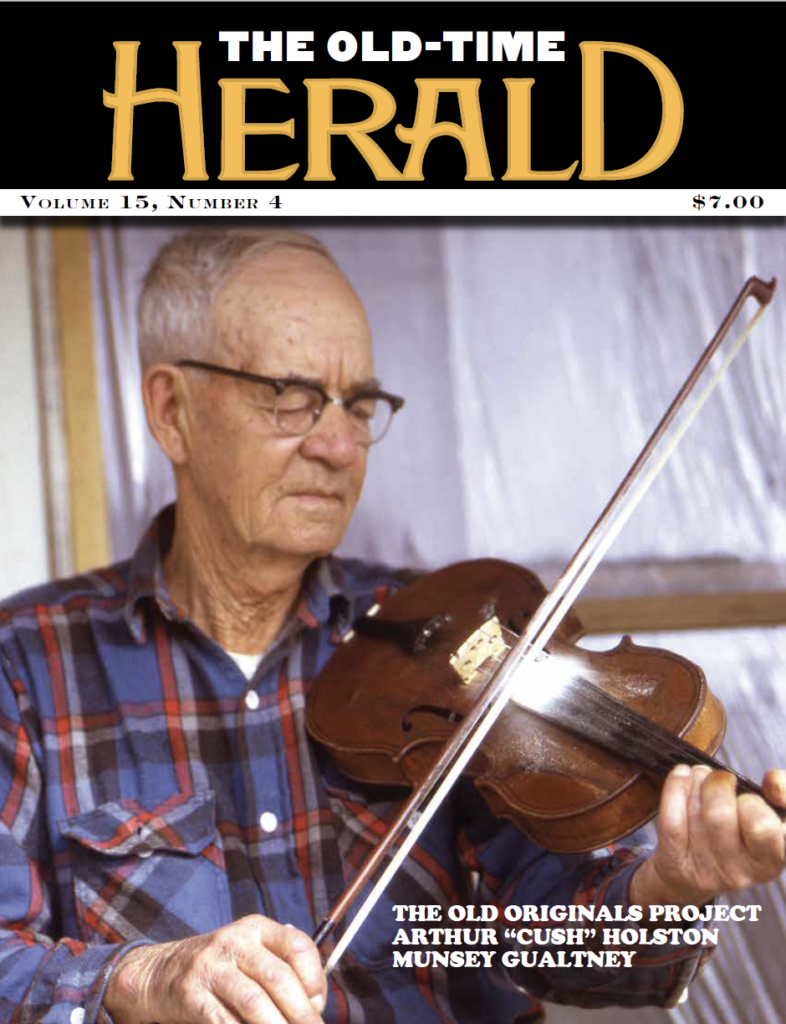For those interested in rounding out their knowledge of Ozark fiddling, this recording of H. K. Silvey should be of great interest. Born in 1933, H. K. Silvey is one of the last of his generation of Ozark fiddlers. His biography reads like a prototype of an old-time fiddler: born on a farm in Ozark County, Missouri, grew up hearing his uncle Jess playing for dances and house parties and learned to back him up on guitar, then secretly learned to play on his uncle’s fiddle and subsequently joined said uncle and other locals to play at dances and parties. Went to work as an airplane mechanic (like another old-time fiddler, Jimmy McCown) and traveled in the course of his job to other states where he played in fiddle contests and with country bands. Went back to farming and local fiddling after he returned home in 1973.
These home recordings were made by Jim Nelson in 2016; he first met H. K. around 20 years before that. In addition to his many field recordings, Jim Nelson is well known for his backup guitar playing, which can also be heard on the Field Recorders’ Collective Bob Holt CD and on various YouTube videos including some great ones featuring fiddler Rhys Jones. His guitar always supports, never intrudes. On this CD, Nathan McAlister on banjo stays very much in the background, also supporting the fiddle in a delicate yet strong way.
Dance fiddling requires something extra that is not required for playing on the back porch or at a party or in a fiddle contest or for listeners. The dancers rely on—nay, they demand—rhythmic drive from the fiddler. It’s got to be the right tempo and has got to have enough momentum for the dancers to be able to keep moving. H. K. plays his tunes with a strong rhythmic propulsion that derives from the single-note bowing. I would have loved to experience H. K. and his uncle Jess fiddling together! That must have been quite a powerhouse.
Like most Midwestern fiddlers, Silvey favors tunes with complex melodies rather than the rhythm-centered fiddling of Round Peak (and many other areas). These elaborate, notey tunes demand a rigorous left-hand accuracy, and speed too. His fiddling retains a feeling of rural country fiddling – not too smooth and definitely not bluegrassy sounding. An occasional “dwell” or extra beat at the end of a section of a tune, like on “Billy In the Lowground” and “Hooker’s Hornpipe,” contributes to the old-time feeling of these tunes.
H. K. Silvey’s accuracy in his bowing is truly impressive. The clarity of his playing (and of this recording) means that this CD could serve as a great tutorial for someone who wants to explore and gain deeper knowledge of old-time fiddle bowing. This is not long-bow, it’s almost all separate notes, at a pretty good clip, yet not at all choppy. Compare Silvey’s “Uncle Herm’s Hornpipe” with John Ashby’s version, which is much smoother, with more slurred notes, more akin to the playing of a bluegrass fiddler. The crunch of the bow attack on Silvey’s version sets each note in relief. Ashby’s is like taking a fast elevator. Silvey’s is like taking the stairs.
All the tunes here (30 of them!) are in standard tuning except for “Black Mountain Rag,” which is in the traditional Calico. Here are many standards like “Ragtime Annie,” “Sugar in the Gourd,” “Billy in the Lowground,” “Eighth of January,” “Fire In the Mountain” (with irregular B part, ending with a nice flourish), and two tunes that I associate with Texas contest repertoire, “Tom & Jerry” and “Twinkle Little Star.” There is only one waltz, “Shepherd’s Waltz,” which is played at a pretty good clip, definitely for dancing.
There are a couple of tunes which are new to me: “Wake Up Little Susan” (which is neither the familiar cross-tuned “Wake Up Susan” nor the Everly Brothers’ song), and “Ball and Chain Hornpipe.” After the latter, there’s a bit of dialogue in which H. K. says he probably learned that tune from Stoneking (which could be either Fred or Lee). It’s really nice to hear his speaking voice!
I always love to hear different interpretations of Arthur Smith, and Silvey plays “Red Apple Rag” in his own style, emphasizing the notey melody and without much “ragging” of the rhythm, although he does sometimes get in a few of those characteristic Arthur Smith slidey notes. But on the whole, his fiddling seems not much influenced by blues or ragtime, more in the reel and hornpipe vein (the up-tempo kind of Midwestern hornpipe, not the dotted-note Celtic kind). In this respect, it’s kind of square. But for me, the excitement of the elaborate melodies and the quick but not rushed tempos make up for the absence of the blues.
Some of us older people had the opportunity to visit with old-time musicians of H. K. Silvey’s generation — musicians who grew up in rural environments without television and whose communities still made their own music — conditions which are hard if not impossible to find today. Many thanks to Jim Nelson for having the foresight to make these (and other) home recordings. We all owe a huge debt to Field Recorders’ Collective for making this and so much other music available!


Leave a Reply